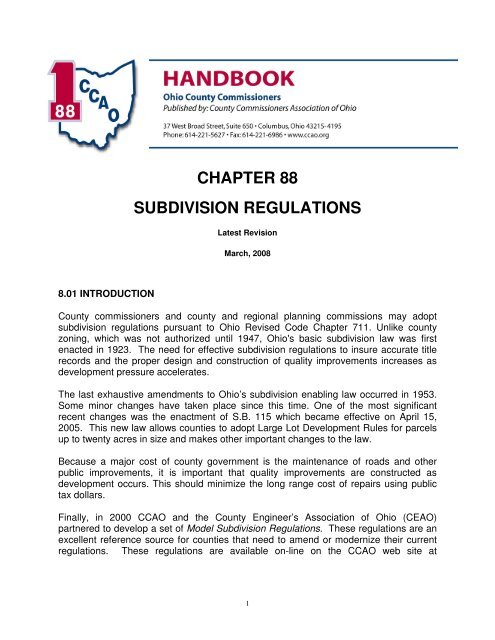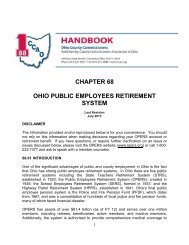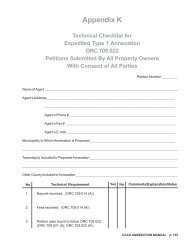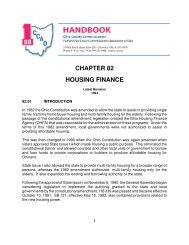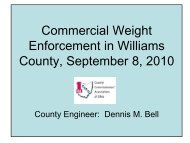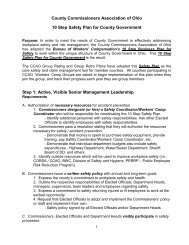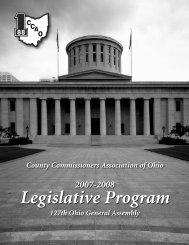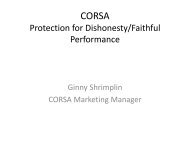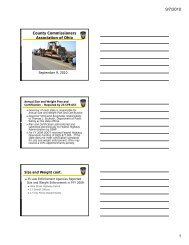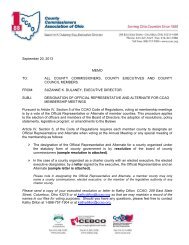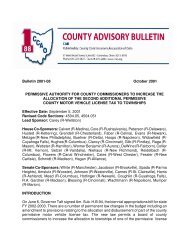Subdivision Regulations (2008) - County Commissioners ...
Subdivision Regulations (2008) - County Commissioners ...
Subdivision Regulations (2008) - County Commissioners ...
You also want an ePaper? Increase the reach of your titles
YUMPU automatically turns print PDFs into web optimized ePapers that Google loves.
http://www.ccao.org/subdivision.html.In addition, available on the CCAO home page are two <strong>County</strong> Advisory Bulletins thatare excellent resource documents. CAB 97-7 discusses H.B. 22, effective 10-21-97dealing with the changes to three mile extra-territorial municipal subdivision jursidictionand may be found at http://www.ccao.org/newsletter/cab199707.htm.CAB 2005-02 explains the provisions of S.B. 115, effective 4-15-05 relating to theauthority to adopt large lot development rules applying to parcels over five acres in sizeand making other changes to the subdivision enabling law. This CAB can be found athttp://www.ccao.org/newsletter/cab200502.htm.While much of the contents of these CAB’s have been incorporated into this revisedchapter of the Handbook, these documents are still good, and sometimes moredetailed, reference sources.88.02 PURPOSE OF SUBDIVISION REGULATIONS<strong>Subdivision</strong> regulations control the division of land, its transfer, and the improvement ofland as development occurs. Unlike zoning, the major purpose which is to control theuse of land, subdivision regulations primarily control the design, layout, division andimprovement of land as it is sold or developed. Under Ohio law (ORC 711.10),subdivision regulations, of uniform application, may be adopted by county and regionalplanning commissions for the following purposes:1. To secure and provide for proper arrangement of streets and highways in relationto existing or planned streets or to the county or regional plan,2. To assure adequate and convenient open space for traffic, utilities, access of firefighting apparatus, recreation, light, air, and3. To avoid congestion of population.88.03 ADOPTION AUTHORITY<strong>County</strong> commissioners have the authority to adopt subdivision regulations under ORCSection 711.05. In addition, a county or regional planning commission has authority toadopt subdivision regulations under the provisions of ORC Section 711.10. <strong>County</strong>commissioners also have the specific authority to adopt improvement regulationspursuant to ORC Section 711.101. This chapter will primarily deal with subdivisionregulations adopted by a county or regional planning commission.Most county subdivision regulations are now adopted and administered by county orregional planning commissions, however, the commission must first adopt "a plan forthe major streets or highways" (ORC 711.10). Once this plan is adopted by thecommission, any plat within the unincorporated area, except for those for which a2
municipality may exert its extra-territorial authority, must be approved by thecommission before it may be recorded.Once the commission adopts subdivision regulations, its approval is "in lieu of anyapprovals provided for in other sections of the Revised Code." After a planningcommission has been created and adopts subdivision regulations the authority toformulate rules and regulations governing the submission of plats and the ultimateapproval of plats has been delegated to the commission.It should also be noted that a county or regional planning commission is required toobtain approval of the county commissioners during the adoption and amendmentprocess. ORC Section 711.10 does not allow the planning commission to adoptregulations requiring the actual construction of improvements or performanceguarantees unless these requirements have been first adopted by the countycommissioners after a hearing. Finally, ORC Section 711.132 requires that thecommissioners must approve all rules and regulations of the planning commissionbefore they become effective.88.04 ADOPTION AND AMENDMENT PROCEDUREUnlike the zoning law, (Chapter 303 Ohio Revised Code and Chapter 86 of thisHandbook) Ohio's subdivision law is less specific concerning the adoption andamendment of subdivision regulations. Part of the problem results from an apparentconflict in the law. ORC Section 711.10 requires the commission to hold a hearingbefore adopting or amending its regulations. The commission is, however, precludedfrom adopting a requirement for the construction of improvements or performanceguarantees "unless such requirements have first been adopted by the countycommissioners after a public hearing."Section 711.132 of the Revised Code, on the other hand, specifies that no regulationwill become effective until it has “been approved after a public hearing by the board ofcounty commissioners." It thus appears that the adoption or amendment ofimprovement regulations must be adopted by the commissioners prior to adoption bythe planning commission. All regulations, however, must be approved by thecommissioners after a hearing before they become effective. These confusingprovisions mean that the exact procedures should be approved by legal counsel prior tobeginning any adoption or amendment process.88.05 ORIGINAL ADOPTIONThe original adoption of subdivision regulations, which includes improvementrequirements, could follow these steps:1. <strong>County</strong> or regional planning commission adopts plan for the major streets orhighways.2. Proposed regulations are drafted by the county or regional planning commission.3
3. An informal hearing is held by the planning commission on the proposedregulations.4. Proposed regulations are revised by the commission and sent to the countycommissioners.5. <strong>County</strong> commissioners hold a public hearing on the regulations, and give 30 daysnotice in a newspaper before the hearing (ORC 711.10, 1963 OAG 395).6. <strong>County</strong> commissioners adopt the regulations and transmit them to the planningcommission.7. The planning commission holds a public hearing on the regulations as adoptedby the commissioners and adopts them. A 30 day notice in a newspaper shouldprecede the hearing. In addition, notice of this public hearing must be sent toeach township in the county by regular or electronic mail at least 30 businessdays before the hearing. It might be possible to combine steps 5, 6, and 7 into ajoint hearing by the commissioners and the planning commission. Adoption bythe county commissioners, however, should precede the adoption by theplanningcommission.8. Certify a copy of the adopted regulations to the county recorder.88.06 AMENDMENT OF IMPROVEMENT REGULATIONSThe amendment of improvement regulations or regulations requiring performanceguarantees should generally follow the procedures outlined in the previous section. Theimportant point is that the commissioners must adopt the amended regulations relatingto improvements or performance guarantees prior to their adoption by the planningcommission.The specific authority for commissioners to adopt improvement regulations is containedin ORC Section 711.101. Under this section, the commissioners have authority to adoptgeneral rules setting standards for improvements and provisions requiring and securingthe construction of improvements shown on plats.These rules may establish standards and specifications for the construction of:1. Streets2. Curbs3. Gutters4. Sidewalks4
5. Street Lights6. Water Mains7. Sanitary Sewers8. Other utility mains, piping, and other facilitiesThe improvement rules may also require complete or partial construction of theimprovements as a condition that must precede the sale or lease of lots in a subdivisionor the issuance of building permits. In lieu of actual construction of the improvements,the rules may require a performance agreement and a performance bond or otherperformance guarantee to assure the construction of the improvements. Theperformance bond or other performance guarantee is limited to improvements directlyaffecting the lots in the subdivision.The rules may provide for the submission of plans and specifications for theimprovements as a condition for the approval of the plat. The rules can not require adeveloper to alter the plans and specifications for improvements as long as they complywith the rules in effect when the plat was submitted for approval.Variances from the improvement regulations are authorized where unusual orexceptional factors or conditions require modifications. The commissioners mayprovide for the administration of the improvement regulations within its office or maydelegate their administration to the county or regional planning commission. Theimprovement regulations may provide for needed inspections and examinations, and forthe issuance of such certificates, permits, and orders as is necessary to enforce theregulations. Before improvement regulations may become effective the commissionersmust hold a public hearing and must give reasonable notice of the hearing in anewspaper (1963 OAG 395). Willful violation of the improvement standards or failure tocomply with orders issued thereto can result in civil penalties of up to $1,000.88.07 AMENDMENT OF OTHER REGULATIONSIf the regulations to be amended do not change improvement or performance guaranteerequirements they need to be approved by the commissioners, but this takes place afteradoption by the planning commission. In this case, the recommended procedure is:1. Proposed amendments are prepared by the county or regional planningcommission.2. The planning commission holds a public hearing, giving 30 days prior notice in anewspaper (ORC 711.10, 1963 OAG 395). In addition, written notice to eachtownship in the county must be sent by regular or electronic mail at least 30business days before the hearing.5
3. Planning commission adopts amendments to subdivision regulations.4. Planning commission transmits adopted regulations to county commissioners.5. <strong>Commissioners</strong> publish 30 day notice of public hearing on the amendments andhold a hearing at a regular meeting of the board (1963 OAG 395).6. <strong>Commissioners</strong> adopt a resolution approving the amendments previouslyadopted by the planning commission.7. Certify the amendments and the resolution of the commissioners approving theadoption by the planning commission to the county recorder.88.08 VARIANCESSection 711.10 of the Revised Code provides that subdivision regulations "may providefor the modification thereof by such county or regional planning commission in specificcases where unusual topographical and other exceptional conditions require suchmodification."Opinion 73-040 of the Attorney General, however, ruled that the planning commission"cannot grant a variance which is in conflict with the rules and regulations." It appearsthat the reasoning was that since the commissioners must first adopt improvement ordevelopment regulations, that variances to such improvement standards cannot bedelegated. It should be noted that in the referenced opinion, the issue was one wherethe planning commission granted a variance in the specifications of private streets in asubdivision that was contrary to the specifications established by the countycommissioners and the county engineer. In some instances, improvement regulations ofthe county engineer are not a part of the subdivision regulations but are simplyreferenced. This may also affect the authority to grant variances and it is always best topose a question about a specific factual situation to the county prosecutor.88.09 ENFORCEMENT --- COUNTY PROSECUTOREven though a regional planning commission is not a "county board" and the countyprosecutor is not required to serve as its legal advisor (1961 OAG 2382), the AttorneyGeneral has apparently distinguished the function of legal advice to the regionalplanning commission under ORC Section 713.21 from the enforcement of subdivisionregulations. The county prosecutor, thus, is the proper agent to institute court action toenforce any violation of the subdivision regulations (OAG 72-020).A series of civil penalties are established in state law relating to subdivision regulations.For example any person who disposes of, offers for sale, or leases for more than fiveyears any lot or part of a lot in a subdivision with the intent to violate the law can pay acivil penalty of up to $500 for each lot or part of a lot. (ORC 711.15). Likewise, anyonewho willfully transfers any lot, parcel or tact of land before a plat has been recorded is6
liable for a civil penalty of up to $500 per lot (ORC 711.13). Finally, a county recorderwho records a plat contrary to the law can also be required to pay a civil fine of up to$500.88.10 APPLICABILITY OF REGULATIONSThe subdivision regulations of the county are applicable to all subdivisions of land in thesubdivision regulation jurisdiction of the county or regional planning commission. Thesubdivision regulation jurisdiction of the county is usually all of the unincorporated areasof the county unless a city of village is exercising extra-territorial jurisdiction pursuant toORC Section 711.09. When administering county subdivision regulations, it is critical tounderstand the exact definition of a subdivision in ORC Section 711.001.Generally speaking, a subdivision is the division of any parcel of land into two or moreparcels, any one of which is less than 5 acres in size. The following are, however,exempt:1. The division of land into parcels greater than five acres and where no new streetsor easements of access are established.2. Parcels of land that are sold or exchanged between adjoining property ownerswhere additional building sites are not created.3. If the county has adopted Large Lot Development rules pursuant to ORC Section711.133, any parcel between 4 and 5 acres that are regulated under the adoptedLarge Lot Development Rules.In addition, a subdivision is also defined to include the improvement of parcels of landfor residential, commercial or industrial structures involving the division or allocation ofland for the opening, widening or extension of public or private streets, except privatestreets serving industrial structures. Likewise, a subdivision is defined as theimprovement of parcels of land involving the division or allocation of land as open spacefor the common use of owners, occupants or leaseholders. Finally, a subdivision alsoincludes the division or allocation of land as easements for the extension andmaintenance of public or private sewer, water, storm drainage, or other similar facilities.The Revised Code, however, does not stipulate who or what agency determines if aland transfer is or is not a subdivision. The cooperation and understanding of the countyauditor and recorder is important to insure the proper administration of the regulations.It should be noted that apartment developments, mobile home parks, and shoppingcenters can also be considered as subdivisions under ORC Section 711.001(B)(2) ofthe Revised Code. Even though land is not being sold or divided, the "improvement" ofthe land by the developer makes it a subdivision. A plat would thus have to besubmitted "showing the portions of the tract which are to be allocated for use as streets,easements, or common open spaces" (OAG 72-020). Some counties also consider7
industrial parks to be subdivisions as they are considered improvements. Other countiesrequire land contracts to comply because they anticipate the future transfer ofownership and division of land.88.11 TYPES OF SUBDIVISIONSAlthough "subdivisions" are popularly associated with larger residential developmentprojects, it should be clear from the prior discussion that a subdivision as defined byOhio law may include the sale of a single lot as well as the approval of a housingdevelopment of 300 lots. Both are technically defined as a “subdivision” under Ohiolaw.Ohio law does, however, recognize these differences and authorizes a procedure wherelots that fall under the definition of a subdivision, but that does not involve intensivedevelopment, may be approved without the requirement of a record plat. Thesesubdivisions are often referred to as either "Major <strong>Subdivision</strong>s" or "Minor <strong>Subdivision</strong>s".Minor <strong>Subdivision</strong>s are also commonly known as "Lot Splits." Following is a discussionof these two types of subdivisions.88.12 MAJOR SUBDIVISIONSThis type of subdivision often involves more than five lots with new streets and otherrelated improvements. A Major <strong>Subdivision</strong> involves the submission of a record plat tothe county or regional planning commission for approval, and its recording by the countyrecorder. Once it is recorded, future transfers of lots in the “platted subdivision”generally do not include a full legal description of the lot, but are simply referenced to alot number on the recorded subdivision plat.The plat of a Major <strong>Subdivision</strong> must describe streets, alleys, commons or publicgrounds and all in-lots, out-lots and fractional lots. The description must include thecourses, boundaries and extent (ORC 711.01). In-lots must be numbered inprogressive numbers and the plat must contain their precise length and width. Out-lots,which do not exceed ten acres, must likewise be numbered, surveyed and their preciselength and width must also be shown on the plat along with any streets, alleys or roadsthat divide or border out-lots (ORC 711.02(A)).Another requirement of a plat is that it must be superimposed on a survey of the landsof the owners of the current parcels. It must contain an accurate background drawing ofany metes-and-bounds descriptions of lands from which the plat in being drawn (ORC711.02(B)).State law (ORC 711.03) also requires certain types of survey monuments includingcornerstones, markers, and pins to identify lots and other survey control points. Thelocations of such markers and control points are usually shown on the plat.8
88.13 PRELIMINARY AND FINAL PLATSPlanning commissions generally require both a preliminary and final plat in addition tovarious engineering and improvement drawings and construction guarantees prior toapproval. While the legal authority to require the submission of a preliminary plat was indoubt for a number of years as a result of a court ruling, the law now specificallyauthorizes county subdivision regulations to require a preliminary plat (ORC 711.01(B)).If a preliminary plat is required, the regulations must provide for a review process for thepreliminary plat. The process must provide for approval, approval with conditions, ordisapproval within 35 business days after submission of the preliminary plat. Thedecision must be in writing and under the signature of the secretary of the county orregional planning commission. If a preliminary plat is disapproved, the reason for thedisapproval must be stated.Once a preliminary plat is approved the applicant may apply for final plat approval. Thelaw (ORC 711.10(C)) requires the planning commission to schedule a meeting toconsider the plat within five calendar days after it is submitted. The commission mustalso send a notice, by regular or electronic mail, to the township fiscal officer and theboard of health where the plat is located. This notice informs the parties of thesubmission of the plat and the date, time and location of any meeting where thecommission will consider or act on the final plat. This meeting must take place within 30calendar days of submission of the final plat, but at least seven calendar days after therequired notices were sent.State law requires the planning commission to take action on a final plat within 30calendar days after it is submitted or the "plat is deemed approved" (ORC 711.10(C)).This time period can only be extended if there is a written agreement with the applicant.The commission may take the following types of action on the final plat (1) approval (2)conditional approval, and (3) disapproval.88.14 CONDITIONAL APPROVAL OF PLATSThe authority to conditionally approve a plat is fairly recent. Prior to this change in law,which applies to both preliminary and final plats, many counties felt they had todisapprove a plat even for minor problems that could be easily corrected. It is now clearthat conditional approval is legally authorized. In addition, a conditional approval shouldspecify a period of time during which the applicant must make the required changes.88.15 OTHER PROVISIONS OF LAW RELATING TO PLATSThe law authorizes county subdivision regulations to require the board of health tocomment on the plat before the commission acts on it, and may require proof ofcompliance with household sewage treatment rules as a basis for disapproval of theplat. In addition, the regulations may also require proof of compliance with anyapplicable county or township zoning regulations. In both cases, recent changes in the9
law may require amendments to the subdivision regulations to implement these newauthorities that have been granted by the General Assembly.On the other hand, the statute specifically prohibits a commission from requiring anapplicant to alter a plat if it is in conformance with the subdivision regulations that werein effect at the time the plat was submitted for approval.Finally, the law also specifically authorizes a county or regional planning commission toenter into a written agreement with a municipality if the city or village is exercising extraterritorialsubdivision authority in the unincorporated area adjacent to the city or village.The agreement may provide that the approval by the city or village platting authority willbe conditioned upon receiving advice from or approval by the county or regionalplanning commission.88.16 APPEAL OF THE DISAPPROVAL OF A FINAL PLATIf the final plat is denied, the ground of refusal must be stated in the minutes of theplanning commission. This must include a citation or reference to the specific rule in thesubdivision regulations that was violated resulting in the disapproval. If the plat isdisapproved, the applicant has 60 calendar days to appeal to common pleas court. Aboard of township trustees does not have standing to appeal the approval or denial of aplat.88.17 DEDICATION AND ACCEPTANCE OF ROADSReaders should also refer to Chapter 30 of this Handbook concerning the relationship ofsubdivision regulations to the dedication and acceptance of roads. Generally speaking,approval of a final plat is not considered an acceptance of the dedication of a road or anopen space shown on a plat (ORC 711.10(C), 711.04).88.18 MINOR SUBDIVISIONS (LOT SPLITS)This type of subdivision usually involves fewer than five lots. ORC Section 711.131allows for this type of subdivision to be approved without record plat. A sketch and"other information," which can include a survey, may be required if provided for in localsubdivision regulations (1953 OAG 3285).It should also be noted that there is no statutory requirement that these subdivisions beplatted or surveyed (ORC 711.40, 1960 OAG 1921). Counties may, however, adoptrules and regulations requiring surveys and plats in such instances under the provisionsof Sections 711.05 or 711.10 of the Revised Code. In the absence of such rules,however, the provisions of the subdivision law may not apply to any division of land byan instrument conveyance (OAG 71-083).In order to exercise review authority over these types of subdivisions, it is necessary tospecify that the requirement is being adopted pursuant to ORC Section 711.131 when10
adopting or amending subdivision regulations. This is necessary, again, because ORCSection 711.40 exempts “the division of any parcel of land by and instrument ofconveyance” unless specifically required by locally adopted subdivision regulations.The director of the county or regional planning commission, or other designated official,has the authority (as the administrative agent of the commission) must determine if theparcel meets the following conditions before it can be approved:1. The land is located along an existing public road.2. The division does not involve the opening, widening, or extension of any public orprivate road.3. No more than five lots are involved after the original tract is completelysubdivided, and4. The proposal is not contrary to any of the following applicable regulations if theyhave been adopted:a. Platting.b. Subdividing.c. Zoning.d. Health.e. Sanitary.f. Access management regulations (ORC Chapter 5552).g. Building code regulations pertaining to existing surface and subsurfacedrainage (ORC 307.37(B)(3)), andh. Rules governing household sewage treatment systems.It should be noted that S. B. 115, effective on 4-15-05, amends ORC Section 711.131 tomake parcels subject to review for conformance with health and sanitary rules, includingrules governing household sewage treatment systems. These were not included underthe former law. Thus, it is now clear that a Lot Split can be denied if it can not complywith the county health department's household sewage disposal regulations. Under theformer law this may not have been authorized.If the designated administrative official finds that a proposed parcel meets theapplicable requirements above, the official is directed to approve the proposed divisionwithin seven business days and stamp the deed or conveyance "approved by (planning11
authority); no plat required." With the change in the law allowing for Large LotDevelopment Rules, CCAO suggests that this stamp be changed to read "approved by(planning authority), no plat required under R.C. 711.131" to ensure that this approval isclearly distinguished from approvals pursuant to ORC Section 711.133 (Large LotDevelopment Rules).The proper administration of minor subdivision regulations can be a controversial andtime consuming job. It is also vital to have the support of the county auditor and countyrecorder who must agree not to transfer or record the land prior to approval by theplanning commission. ORC Section 711.121 of the Revised Code specifies that thecounty auditor and recorder "....shall not transfer property or record deeds or leaseswhich attempt to convey property contrary to the provisions of Chapter 711 of theRevised Code."In the past, some counties have experienced a circumvention of subdivision regulationsby individuals using Chapter 5307 of the Revised Code dealing with "partition" actions incourt. However, the legislature enacted legislation (HB 296, 9-4-84) closing thatloophole by requiring that all partition actions initiated pursuant to ORC Sections5307.06, .07 and .08 must comply with local subdivision regulations.Finally, many counties have adopted land conveyance standards pursuant to ORCSection 319.203 and requirements for boundary surveys under ORC Section 315.231.These will be explained in a subsequent section of this Chapter of the Handbook.88.19 THE DEFINITION OF ORIGINAL TRACT AND COMPLETELY SUBDIVIDEDTo properly administer minor subdivision regulations, it is important to understand thedefinition of the terms “original tract” and “completely subdivided” in the statute. Theissue of how these two terms are applied locally is one of the more confusing areas ofsubdivision law, and many counties do this differently.Rather than trying to explain the various rulings of the Attorney General on this topic,readers are encouraged to refer to the various opinions that have been issued on thistopic. Please refer to 1964 Ohio Attorney General Opinion Number 1044 and to OAGOpinions 69-161, 71-083, 84-073, 85-004, and 97-019.A major change in this section, however, became effective with the enactment of S.B.115, effective 4-15-05. The change grants permissive authority to amend thesubdivision regulations to apply the term "original tract" differently than it has beendefined by previous rulings of the Attorney General. Generally, counties shouldcontinue to do what they have been doing in this regard and follow the advice of legalcounsel if they do not take advantage of the new law to change how to apply the termoriginal tract.S. B. 115 authorizes an amendment to the subdivision regulations so that the planningauthority would approve proposed divisions of parcels of land without a plat under a12
new Division (B) of ORC 711.131. If such an amendment is adopted, the new lawprovides that: "If the authority so amends its rules, it may approve no more than five lotswithout a plat from an original tract as that original tract exists on the effective date ofthe amendment to the rules." This means that no more than five lots, including theoriginal tract, may be approved without going through the major subdivision process.The original tract will be defined as any parcel that exists at the time the amendment tothe subdivision regulations becomes effective.In addition, if a county wants to amend its regulations to change the way to count thenumber of splits that are allowed without a plat, this amendment to the subdivisionregulations must be completed no later than two years after the effective date of the act,or not later than 4-15-07. After this date the definition of original tract can not bechanged through amendment of local subdivision regulations. Counties that desire tomake this change need to begin this process far enough in advance of the deadline sothat the change in the subdivision regulations becomes effective by 4-15-07.In addition, it should be noted that the two-year window applies only to the original tractchange, and does not apply to any other provisions of S.B. 115, including the authorityto adopt Large Lot Development Rules which will be discussed next.88.20 LARGE LOT DEVELOPMENT RULESThe most important new authority granted to counties under S. B. 115 is the power toadopt rules so that new parcels of up to 20 acres in size may become subject to a newmid-level review and approval process. This authority is granted under ORC Section711.133. Remember that, generally speaking, any parcel over five acres in size is not,by definition, a subdivision and is thus not subject to any review under ORC Chapter711.The new law authorizes the Large Lot Development Rules to designate the size rangeof parcels that will be subject to Large Lot Development approval. It should be notedthat the term “Large Lot Development Rules” will not be found in the ORC. This term,along with the terms “Major and Minor <strong>Subdivision</strong>s” and “Lot Splits” are not statutoryterms but are common terms used in an effort to distinguish these types of approvals.When adopting Large Lot Development Rules, counties should follow the sameprocedure required to adopt or amend subdivision regulations.When adopting Large Lot Development Rules, the size of parcels subject to approvalmay be in the range of not less than 4 acres nor more than 20 acres. Thus, countiesthat choose to take advantage of this new authority could make the new law apply tolots between 4 and 20 acres, or they could choose to make the new law apply only toparcels greater than 5 acres and up to 20 acres. Another option would be to make thenew law apply to a lesser number of acres, for example, parcels of up to only 10 acres.These are decisions to be made locally.If, however, Large Lot Development Rules are adopted that include parcels between 413
and 5 acres, "the rules shall state that the proposed division (of parcels between 4 and5 acres) shall not be considered a subdivision for the purposes of division (B)(1) ofSection 711.001 of the Revised Code and need only be approved as specified inDivision (A) of this Section (ORC 711.133) and the rules adopted under this section."In addition, the rules adopted under ORC Section 711.133 "shall exempt from theapproval requirements of this section parcels of land to be used only for agricultural andpersonal recreational purposes." This portion of the bill was one of the compromisesthat CCAO accepted during the process of passing the bill, and will be discussed ingreater detail later.The approval process of parcels subject to Large Lot Development Rules is similar tothe process for the approval of Minor <strong>Subdivision</strong>s under ORC Section 711.131. Inorder for the lot to be subject to approval under the Large Lot Development Rules, thefollowing must apply:1. The proposed division must be along an existing public street;2. The proposed division must not involve the opening, widening, or extension ofany street or road; and3. The proposed division must involve the establishment of a lot within the acreagerange that is specified in the Large Lot Development Rules.4. Once it is determined that the lot is subject to approval pursuant to the Large LotDevelopment Rules as specified above, the administrative official must determinethat the proposed division is not contrary to applicable:a. Zoning.b. Health.c. Sanitary.d. Access management regulations (See ORC Chapter 5552).e. Building code regulations pertaining to existing surface and subsurfacedrainage (See ORC 307.37(B)(3)).f. Rules governing household sewage treatment systems, andg. Rules that regulate lot frontage and width-to-depth ratios.As is the case for Minor <strong>Subdivision</strong>s, Large Lot Developments are submitted to theadministrative official designated in the Large Lot Development Rules for approvalwithout a plat in accordance with ORC Section 711.133. No public hearings are14
equired. As is the case for Minor <strong>Subdivision</strong>s, the statute allows for the submission ofa sketch and other information that is pertinent for determining if the parcel should beapproved.The administrative official must stamp the conveyance "approved by (planning authority)no plat required" and have it signed by the administrative official. We suggest that thestamp actually read, "approved by (planning authority); no plat required under R.C.711.133."It is also suggested that approvals of Minor <strong>Subdivision</strong>s be stamped "approved by(planning authority); no plat required under R.C. 711.131” in an effort to distinguish thetwo types of approvals without a plat. Likewise, those parcels that are within the rangespecified in the Large Lot Development Rules which are exempt under the agriculturaland personal recreational purposes exemption should be stamped "no approval or platrequired under R.C. 711.133; for agricultural or personal recreational use only."88.21 LARGE LOT DEVELOPMENT REGULATIONS PERTAINING TO LOTFRONTAGE AND WIDTH TO DEPTH RATIOSAs was mentioned in a previous section, one of the criteria for the approval of lotssubject to Large Lot Development Rules is compliance with lot frontage requirementsand width-to-depth ratios. It should be noted that Division (B) of ORC Section 711.133specifically authorizes the Large Lot Development Rules to regulate lot frontage andwidth-to-depth ratios for lots approved under this new authority.In addition, the statute provides that these lot frontage requirements or width-to-depthratios apply to parcels approved under the Large Lot Development Rules only if "there isno applicable zoning regulation for lot frontage or width-to-depth ratios that apply to theparcel." Thus, if county or township zoning is in effect and the zoning resolution containslot frontage or width-to-depth ratios, these take precedence over those included in theLarge Lot Development Rules irrespective of whether the requirements in the zoningresolution are more or less stringent than those established by the Large LotDevelopment Rules.88.22 SPECIAL PROVISIONS FOR PARCELS EXEMPT FROM LARGE LOTDEVELOPMENT RULES BECAUSE THEY ARE TO BE USED ONLY FORAGRICULTURAL OR PERSONAL RECREATIONAL PURPOSESTo review previous sections, Large Lot Development Rules must "exempt from theapproval requirements of this section parcels of land to be used only for agricultural andpersonal recreational purposes" (ORC 711.133(C)). In this case the statute providesthat the administrative officer is to stamp the conveyance "no approval or plat requiredunder R.C. 711.133; for agricultural and personal recreational use only."While the statute is silent on how a determination is made if a parcel qualifies for theagricultural and personal recreational use exemption, it does specify that parcels15
exempted under this provision shall not be excluded from regulation under ORCChapter 711 for any "future divisions or partitions of those parcels." Further, for parcelsof land that are exempt as a result of the agricultural and personal recreational useexemption which are "subsequently to be used for other than agricultural or personalrecreational purposes, the planning authority shall first determine that such a parcelcomplies with the rules adopted under this section."This provision of the new law is one of the more difficult to understand and to apply. Ithas been suggested that the determination of whether a parcel qualifies for theagricultural and personal recreational use exemption is one where counties may have torely on signed statements from owners and buyers of land. A form could be designedthat requires both parties to certify that the land will be used only for agricultural orpersonal recreational use. It might also be wise to include some standards to be used todetermine if parcels qualify for both agricultural and personal recreational useexemptions.As a result of this exemption in the statute, it might be preferable to only apply Large LotDevelopment Rules to lots over 5 acres, not to lots in the range of 4 to 5 acres as thestatute permits. If a county adopts Large Lot Development Rules for parcels of 4 to 5acres, the agricultural and personal recreational use exemption can be claimed. Nosuch exemption is available for Minor <strong>Subdivision</strong>s approved pursuant to ORC Section711.131.88.23 TIME PERIODS FOR APPROVAL OF LOTS SUBJECT TO LARGE LOTDEVELOPMENT RULESWhen approving lots subject to Large Lot Development Rules, the designatedadministrative official is directed to approve the parcels within certain time frames thatvary with the number of lots or parcels that are submitted for approval as follows:Number of ParcelsUp to the Number of Days1-6 7 Calendar Days7-14 14 Calendar Days15 Or More 21 Calendar Days88.24 APPLICATION OF LARGE LOT DEVELOPMENT RULES TO PARCELSBETWEEN 4 AND 5 ACRESCurrently under ORC Section 711.131, Lot Splits or Minor <strong>Subdivision</strong>s are subject toapproval without a plat if the parcel being conveyed is not greater than 5 acres in area.With the enactment of S. B. 115, Large Lot Development Rules may be adopted thatapply to parcels between 4 and 20 acres. Thus, if such regulations are adopted thatinclude parcels of from 4 to 5 acres in size, the Minor <strong>Subdivision</strong> process would onlyapply to parcels of up to, but not including 4 acres.16
CCAO questions if it would be beneficial to include lots in the 4-5 acre range underLarge Lot Development Rules. There are two reasons it may not be beneficial. First,under the Large Lot Development Rules adopted pursuant to ORC Section 711.133,parcels for agricultural and personal recreational purposes are exempt. Second, theapproval of parcels under the Large Lot Development Rules may not consider "plattingand subdividing rules" which may be considered under the Minor <strong>Subdivision</strong> processpursuant to ORC Section 711.131.88.25 MANDATORY DEDICATION OF OPEN SPACEWhile counties generally do not have the authority to impose impact fees on newdevelopment and efforts are being made to pass enabling legislation for impact fees,the Attorney General has ruled (OAG Opinion 7113 of 1956) that a county or regionalplanning commission may require the dedication of a reasonable amount of land forpark purposes as a condition precedent to approval of a plat.Some believe that under this authority a county could find that “for every additionalsingle-family lot developed or home constructed, the incremental need is created for acertain amount of land for parks. That need could be offset by mandated dedication ofland on-site for park purposes or the payment of a fee-in-lieu so that a park couldeventually be purchased and developed off-site”. 1In addition, great care must be taken in developing the methodology by which it isdetermined how much land is to be dedicated or how fees-in-lieu of dedication arecalculated. For more information see C. Reed, Formulas and Standards for ParklandDedication, 11 The Zoning Report, No. 13 (October 22, 1993). This publication isavailable from P.O. Box 6529, Margate, Florida 33063.88.26 LAND CONVEYANCE STANDARDS AND BOUNDARY SURVEYREQUIREMENTSThe county auditor and the county engineer, by written agreement, may adoptstandards governing the conveyance of real property in the county (ORC 319.203).These standards may include the requirements of ORC Section 315.251 dealing withboundary surveys. Once these standards are adopted the county auditor must reviewall conveyances to determine compliance with the standards and can not allow transferif the conveyance does not comply with the standards.In order to adopt or modify these standards the county auditor and the county engineermust hold two public hearings at least ten days apart and the standards must beavailable for public inspection in both offices during normal business hours.If a deed conveying real property is presented to the county auditor for transfer and itcontains a legal description for land that is cut-up or split from an existing parcel or if thelegal description of the land to be conveyed is different from the legal description in theprior deed a boundary survey plat in conformity with the new description must be17
submitted with the deed for transfer. The boundary survey plat and property descriptionon the deed must meet the minimum standards for boundary surveys pursuant to ORCChapter 4733. If the boundary survey plat and legal description in the deed comply withthese requirements as determined by the county engineer then the county auditor willaccept the deed for transfer. A copy of the survey plat is then filed in the countyengineer’s survey file and is open for public inspection.Finally, if the county engineer is not a “full-time” engineer and is still engaged in theprivate practice of engineering and surveying, the county auditor must designateanother engineer employed in the county engineer’s office to perform the duty of thecounty engineer so as to avoid any conflict of interest (See ORC 315.251(B)).88.27 NOTICE REQUIREMENTS TO TOWNSHIP TRUSTEESOhio law requires the planning commission or the county commissioners to notify thetownship trustees of proposed plats in the township. Counties are required to givetownship trustees notice of any meeting where the plat will be considered or approved.Following are some additional aspects of this requirement:1. The notice must be sent to the trustees within five calendar days after the plat isreceived,2. The notice must state that the plat has been submitted and the date, time, andlocation of any meeting where the plat will be considered or acted on,3. The notice is sent by either regular mail or electronic mail,4. The meeting can not occur until at least seven calendar days after the notice wassent to the township,5. This procedure does not eliminate the requirement that the plat be acted onwithin 30 calendar days after submission.It should be noted that this requirement applies only to the final plat, not to thepreliminary plat. While the law does not require this notification on a preliminary plat,this appears to have been an oversight when the law was recently amended tospecifically authorize a preliminary plat. Thus, CCAO recommends that notice also begiven on the filing of a preliminary plat.In addition, when a county adopts or amends subdivision regulations the statue requiresall townships to be notified on any public hearing on the regulations or amendment.This notice must be given by regular or electronic mail at least 30 business days beforethe meeting.88.28 EXTRATERRITORIAL MUNICIPAL JURISDICTION18
Cities and villages have been granted limited authority to control subdivisions in theunincorporated area of the county under ORC Section 711.09. Under former law, citieshad the right to approve plats within three miles of the city and certain villages had theright to exert this authority in an area of up to one and one-half miles of the village. Thisall changed in 1997 when the legislature enacted H.B. 22.With this change in the law cities may no longer exert the three mile extra-territorialjurisdiction if all of the following conditions exist:1. The township that is within three miles of the city is covered by a county ortownship zoning resolution;2. The county has a county or regional planning commission; and3. The county has adopted subdivision regulations.Likewise in the case of villages, they may no longer exert their extra-territorialjurisdiction under the same conditions as exist for cities, plus the only villages that havethe authority to exert this jurisdiction are those located in counties that contain no cities.The practical effect of this change in state law is to eliminate the extra-territorialjurisdiction of many municipalities. Since most counties have both established planningcommissions and adopted subdivision regulations, city jurisdiction in the three mile areaand village jurisdiction in the one and one-half mile area is primarily limited tounincorporated townships where the residents have not adopted zoning.In addition, for those cities and villages that may still exert extra-territorial jurisdictionunder the restrictions enacted in H.B. 22 there is another limiting requirement in the law.In order to exert this extra-territorial control the city or village must adopt "a plan for themajor streets or thoroughfares and for the parks and other public grounds of the city"and all or any part of the three mile or one and one-half mile area as the case may be. Ifthe land is within three miles or one and one-half miles of more than one city or village,the municipality closest has jurisdiction.The law (ORC 711.09 (D)) also provides that if the county contains five or more citiesand the county or regional planning commission had adopted a resolution to exercisesubdivision regulation authority within the three mile area (refer to 1962 OAG Opinion3285 for more details) the city may not exert any extra-territorial jurisdiction. Thisprovision applies only to cities and not to villages.Once the city or village planning commission, which is still authorized to exert extraterritorialjurisdiction under the new provisions established under H.B. 22, has adoptedthe required plans for the area of jurisdiction, the city or village has "exclusivejurisdiction as to the approval of plats.....and the county or regional planningcommission has no jurisdiction as to that area" (1962 OAG 3285).19
A city or village also may adopt regulations that establish standards and specificationsfor streets and other public improvements in the unincorporated area which must becomplied with "as a condition precedent to the approval of a plat.....by the city (orvillage) planning commission" (1962 OAG 3166). The acceptance of the dedication ofthe streets, however, must still involve the appropriate action of the countycommissioners (Adamson v Wetz, 69 Abs 281).Finally, state law (ORC 711.10(C)) also authorizes a city or village and the county orregional planning commission to enter into a written agreement "...that approval of theplat...shall be conditioned upon receiving advice from or approval by the county orregional planning commission." This provision allows a method to provide the type ofcooperative arrangements that could prove beneficial.88.29 ABILITY TO ALLOW MUNICIPALITIES TO CONTINUE TO APPROVE PLATSCCAO has been asked whether the county can continue to allow a city or village toexercise its former extra-territorial control. It has been pointed out that ORC Section711.10 allows, by written agreement, a city or village to condition its approval "uponreceiving advice from or approval by the county or regional planning commission."It appears that this provision of law is no longer practically operative given the fact thatmunicipal extra-territorial authority really only exists where there is no county ortownship zoning. This provision of law thus appears to only apply to a situation where amunicipality retains jurisdiction because the territory does not meet the standards forexclusive county control.Another option might be for the county to contract with the municipality. The generalauthority for contracts with other political subdivisions is contained in ORC Section307.15. Using this section of Ohio law it might be possible to maintain the formersystem or something close to it; however, an opinion from the county prosecutor shouldbe obtained first. In particular, refer to OAG 75-085.88.30 CONDOMINIUM PROPERTYCondominium property is an increasingly popular type of property ownership. Chapter5311 of the Revised Code deals with condominium property in detail. Undercondominium ownership, land is not actually divided or transferred and "neither thesubmission of property to the provisions of this chapter (ORC Chapter 5311) nor theconveyance or transfer of a condominium ownership interest constitutes a subdivisionwithin the meaning of, or is subject to Chapter 711 of the Revised Code" (ORC5311.02).The Attorney General has ruled (OAG 86-074) that condominium property is exemptfrom any platting requirements that may be imposed under ORC Chapter 711 and thatthe county or regional planning commission has no authority to review condominiumplats. Likewise in a city case, the court ruled that a city could not attempt to redress20
alleged deficiencies in a condominium development using its subdivision ordinance(Ohio Mall Contractors, Inc. v. Dickinson, 65 Ohio App. 3d 806).Some developments that purport to be a "condominium development," and thus exemptfrom subdivision regulations, may not actually be a condominium under Ohio law. Forexample, "property can not be qualified as a condominium...where it consists of a groupof lots, where each lot is intended for private ownership and where the "common areas"consist primarily of roads and similar types of commonly used property (OAG 71-031).At times, particularly in small counties, a developer may attempt to exclude review of hisdevelopment under the county's subdivision regulations by calling it a condominium,planned development or other fancy term. Legal advice should be obtained in suchinstances to determine if the development does actually fall within the jurisdiction of thesubdivision regulations.88.31 LAND CONTRACT SALESOne problem area that often arises is the relationship of subdivision regulations to salesof land by executory contracts, commonly referred to as land installment contracts. Aproblem arises because at the time of the execution of the contract, no land is actuallybeing transferred although the execution of the contract anticipates a future transfer ofownership. It would thus seem prudent to assure that the division that is anticipated bythe land contract complies with the subdivision regulations so that the lot will meet therequirements of the regulations when actual transfer of ownership occurs.The vendor of any land installment contract that contains a metes and bounds legaldescription must obtain the approval of the county engineer on the contract when theengineer reviews the description as required by law, effective March 19, 1993 (ORC5313.02). In addition, all land contracts executed after September 29, 1961 must berecorded by the county recorder (ORC 317.08(A)(2)(b) and 5301.25). The law alsorequires the vendor to deliver a copy of the contract to the county auditor within 20 daysafter the contract has been signed by both parties (ORC 5313.02).Although there have been no formal legal rulings on the issue, a land contract might fallunder the definition of a subdivision which deals with divisions of land ".....for thepurpose, whether immediate or future, of transfer of ownership...." (ORC 711.001).It might thus prove helpful, with the agreement of the county engineer, to have landcontracts referred to the planning commission to assure conformance to lot size andother related requirements. Such a voluntary procedure could insure that the purchaserwill be able to receive a deed when all payments are completed and the actual transferoccurs. It may also minimize variances that are often requested later.In addition, many counties require land contract sales to comply with land conveyancestandards adopted jointly by the county engineer and the county auditor pursuant to21
ORC Section 319.203.Likewise, it might be helpful to work with the county auditor and recorder in a similarmanner, although since the contract is executed prior to the time it is filed for recordingand transmittal to the auditor, this may be too late in the process to assure that thecontract conforms to lot area and other requirements. It is recommended that provisionfor land contracts be included in locally adopted subdivision regulations. For furtherinformation refer to Chapter 5313 of the Revised Code - Land Installment Contracts.1 Meck, Stuart and Pearlman, Kenneth, Ohio Planning and Zoning Law. Baldwin’s Ohio HandbookSeries, Thompson/West Publishing, Cleveland, Ohio, 200522


